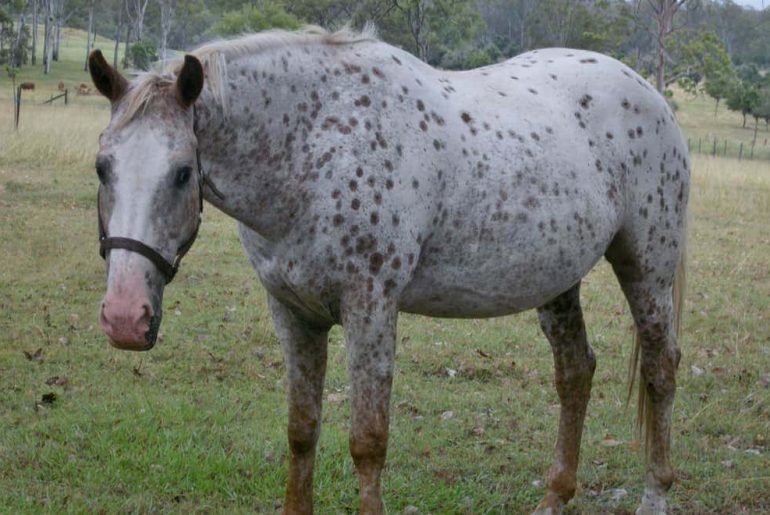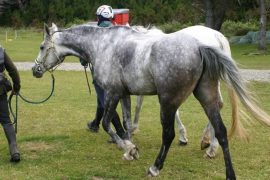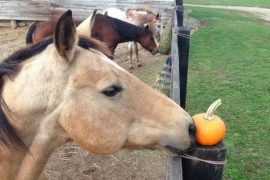What is hair loss in horses?
Hair loss in horses occurs when less hair is produced or the horse sheds more hair. The horse has hairless patches on the coat, the skin beneath the hairless patches is unaltered.
In veterinary medicine, hair loss is referred to as alopecia or effluvium. Veterinarians differentiate between hair loss that is limited to a few spots (alopecia areata) and hair loss that affects large parts of the coat (alopecia generalisata).
There are many causes of hair loss, for example infectious diseases, poisoning and hormonal imbalances. If the cause of hair loss in the horse is unclear, it is referred to as “idiopathic alopecia”.
What are the causes of hair loss in horses?
There are many causes of hair loss in horses. Among other things, the triggering causes of hair loss in horses are:
- Infectious diseases, e.g. equine flu (equine influenza), druse, bacterial infections (e.g. salmonellosis, streptococcal infection)
- Metabolic diseases, high fever: A few days after a serious illness, which is often accompanied by fever, the horse suddenly loses its hair. This is due to damage to the hair follicles. The tail and mane are unaffected by the hair loss.
- Stress factors such as pregnancy or shock can lead to hair loss – this typically occurs two to three months after the triggering factor. In the next coat cycle, the coat grows back normally.
- Poisoning, for example by thallium, mercury or iodine
- Psychogenic Alopecia: The horse has injured itself, causing the hairless patches.
- Circumscribed alopecia (idiopathic alopecia): The horse has several round bald spots distributed over the body, for which no exact cause is known to this day. Veterinarians suspect a hormonal, genetic or autoimmune cause of this hair loss in horses.
- Hormonal alopecia: Hormonal imbalances can lead to hair loss in horses, for example due to Cushing’s syndrome in horses
- Foals often lose their entire foal coat before the new permanent coat grows. However, this hair loss is not pathological.
- Skin fungus (dermatophytosis)
- mites
- Pressure points, for example due to saddle pressure on the horse
What is hair loss in horses?
Hair loss in horses is characterized by the loss of fur. This disease, also known as alopecia, can be limited to a few areas of the hair coat or spread to large parts. The skin below the hairless areas is unchanged. In some cases, symptoms of the underlying disease that caused the disease are also noticeable, such as fever or itching.
Does Cushing’s cause hair loss in horses?
Also known as equine Cushing’s disease, PPID can cause signs that are subtle and easy to miss, such as a decrease in activity. The disease can progress to include loss of muscle mass and hair coat changes. “They may seem quieter than normal, perhaps duller,” notes Nicholas Frank, DVM, Ph.
How do I get my horse’s face to grow back?
A damp towel can do wonders. Vigorous grooming stimulates natural protective oils as well as exfoliates to release them. So, gently groom faces well. If you do wrestle with hair loss, Lucky Braids All-In-One Horse Shampoo will help promote healing and quick re-growth of hair from loss or rubs.
How does Cushing’s disease affect horses?
Clinical signs include increased coat length and delayed shedding of the winter coat, laminitis, lethargy, increased sweating, weight loss and excessive drinking and urinating. The disease primarily affects those over the age of 10, with 19 being the average age at diagnosis.
How can you tell if a horse has Cushings?
- Failure or later shedding of the winter coat that may become really long, matted and curly especially around the legs.
- Excessive sweating.
- Increased drinking and urination.
- Lethargy and poor performance.
- A pot-bellied appearance.
- Loss of muscle and topline.
- Abnormal fat distribution particularly above the eyes, the crest of the neck and above the tail head.
- Chronic or relapsing laminitis.
- Delayed wound healing, increase in infections of the skin and susceptibility to internal parasites.
What causes horses to lose patches of hair?
Hair loss in the horse can be caused by something simple, such as environment and temperature, or it can be caused by an infectious skin disease, such as ringworm (fungus) that invades the hair follicles of the skin; dermatophilosis, a superficial bacterial skin disease; or be the result of scratching due to an …
What are the signs of PPID in horses?
Horses with PPID often have long, curly hair coats and delayed shedding. The most common clinical signs of PPID are a long, curly hair coat (hypertrichosis), delayed shedding, loss of muscle (especially along the topline), abnormal thirst (polydipsia), excessive urination (polyuria), lethargy, and laminitis.





